It is one of the great ensembles of neoclassical design: the entrance to the temple du lait at Rambouillet is framed by Tuscan columns; inside, we encounter an elegant rotunda inspired by the baths of Diocletian; beyond we enter a grotto formed from irregular stones that frame the statue of a deity, the walls lined with bas-reliefs in Carrara marble extolling agricultural labour. While we are all familiar with the cottages at Versailles, and Marie Antoinette’s milkmaid reveries, the Rambouillet dairy took the idea of natural virtue and patriotic renewal to its apogee. Dominating the grotto was a marble statue by Pierre Julien of Amalthea, the nymph who according to Ovid nursed the infant Zeus with goat’s milk. The allegorical implications were inescapable considering the recent birth of the dauphin: Marie Antoinette was also the nurturing mother of the gods. The dairy belonged both to Enlightenment discourses around health and fecundity and to the 18th-century dream of being initiated into secret mysteries. Only the neighbouring chateau spoiled the illusion, its gothic aspect apparently repulsive to the queen. A drastic classical redesign was conceived by the architects Jean-Augustin Renard and Jacques-Jean Thévenin, but never executed.
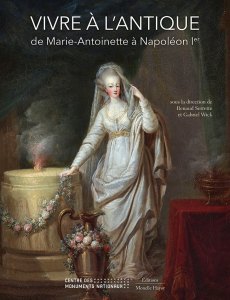 Despite the enduring association with Marie Antoinette, she visited the site only once, in June 1787, and it is probable neither she nor her husband entirely approved of the finished results. Rambouillet was created by an outstanding team of artists, above all the astonishingly versatile Hubert Robert, whose influence extended from the furniture and the porcelain to the gardens. Other names who worked on the project are less familiar today; they include Jean-Jacques Lagrenée and Louis-Simon Boizot, who designed the 65-piece porcelain service, and Louis Le Masson, creator of panoramic views of Rome intended to adorn the rotunda. Yet each member of the team sought to reproduce and renew the language of antiquity, sometimes at its most uncompromising. Rambouillet chafed against the courtly ideals of elegance and decorous interiors; instead, its visionary classicism was closer in spirit to the creations of adventurous private patrons, such as the gardens of Méréville (which belonged to the banker Jean-Joseph, Marquis de Laborde), or the extraordinary, and still extant, Grand Rocher at the Folie Saint-James, where François-Joseph Bélanger married the ruins of Herculaneum with cutting-edge hydraulics.
Despite the enduring association with Marie Antoinette, she visited the site only once, in June 1787, and it is probable neither she nor her husband entirely approved of the finished results. Rambouillet was created by an outstanding team of artists, above all the astonishingly versatile Hubert Robert, whose influence extended from the furniture and the porcelain to the gardens. Other names who worked on the project are less familiar today; they include Jean-Jacques Lagrenée and Louis-Simon Boizot, who designed the 65-piece porcelain service, and Louis Le Masson, creator of panoramic views of Rome intended to adorn the rotunda. Yet each member of the team sought to reproduce and renew the language of antiquity, sometimes at its most uncompromising. Rambouillet chafed against the courtly ideals of elegance and decorous interiors; instead, its visionary classicism was closer in spirit to the creations of adventurous private patrons, such as the gardens of Méréville (which belonged to the banker Jean-Joseph, Marquis de Laborde), or the extraordinary, and still extant, Grand Rocher at the Folie Saint-James, where François-Joseph Bélanger married the ruins of Herculaneum with cutting-edge hydraulics.
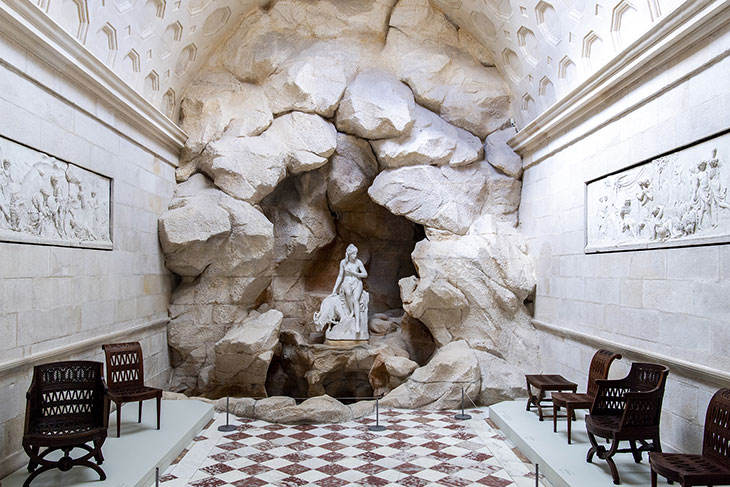
Installation view of ‘Vivre à l’antique‘ inside the Queen’s Dairy at the Château de Rambouillet. Photo: © Thibault Chapotot/CMN
The temporary return of porcelain and furniture to the dairy is the centrepiece of an exhibition (until 9 August) that has also inspired an essay collection edited by Gabriel Wick and Renaud Serrette. Vivre à l’antique is a series of sumptuously illustrated short essays by leading scholars that provide different contexts for understanding the laiterie de la reine. These range from the intellectual and ideological to the technical and the economic: Comte d’Angiviller, prime mover behind transforming the site, was determined to modernise the production of Sèvres and was deeply influenced by the Physiocrats’ teaching that agriculture was the foundation of public prosperity and happiness. Beyond its dairy, the estate at Rambouillet was a laboratory of experimental agronomy, with flocks of merino sheep, and botanical specimens sourced from around the globe thanks to the travels of André Michaux.
Neoclassicism was the first pre-eminently international style, and the essays situate Rambouillet at the confluence of different European trends. Rivalry with Britain – as refracted through the vase collections of William Hamilton or the bold designs of Josiah Wedgwood – spurred French designers to apply the principles of antiquity to modern life. Knowledge of ancient practices, although much enriched by recent excavations, remained contentious. Many continued to ascribe the red-figure pottery unearthed in Italy to the Etruscans, rather than to the Greeks, prompting a wave of neo-Etruscan designs, including the curule chairs with sabre legs and open-work lattice pattern created by Georges Jacob. Time and again, we can find designs that married the learned with the ludic: consider the wallpapers of Pierre Cietty, covered in beguiling arabesques and fantastic creatures. Classical archetypes inspired fresh iterations and reinventions, on every conceivable scale, which over time left the original source material far behind.
Beyond its role as a stimulus to artisans and designers, the essays point to antiquity as a source of powerful fantasies and identifications for patrons and statesmen too. Wick reflects on the links between neoclassical decorative schemes in British country houses and their owners’ colonial fortunes, drawing out the role of Greco-Roman references in elevating and legitimising, through the rhetoric of civilisation, often highly exploitative forms of personal enrichment. Yet the cynical exploitation of antiquity must be weighed against its idealistic or escapist elements: idylls of arcadian simplicity co-existed with stirring tales of ancient virtue and the promise of moral and social regeneration. Not all of those who postured in classical dress were able to pull it off. Charles Leclercq’s portrait of Marie Antoinette in the guise of a Vestal Virgin did nothing to deter the fatal attacks on her character.
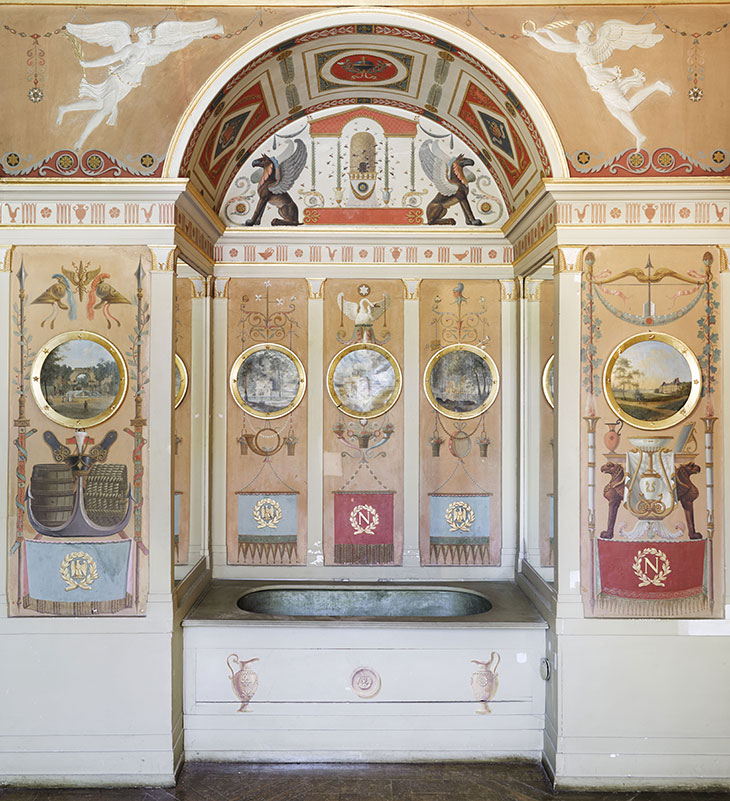
The Emperor’s bathroom at the Château de Rambouillet. Photo: © Benjamin-Gavaudo/CMN
Many of the core decorative elements of the Rambouillet dairy were dispersed during the Revolution. It fell to Napoleon to assign the remaining vestiges to Joséphine at Malmaison – aside from the statue of Amalthea, which he installed in the Senate (it returned to Rambouillet in 1953) – and to convert the former royal boudoir into a bathroom decorated like an ancient triumphal arch (its iconography lucidly analysed here by Serrette). By the mid 19th century, this site of Enlightened science, archaeological wonder and royal maternity was given a salacious new interpretation: the Goncourt brothers speculated that the breast-shaped cups, in fact derived from ancient archetypes (the Greek mastos), had been directly modelled on Marie Antoinette’s body. Although the case it made for the queen’s virtue fell flat, the Rambouillet dairy gives a unique insight into the romance of antiquity in 18th-century France.
Vivre à l’antique: de Marie Antoinette à Napoléon 1er by Renaud Serrette and Gabriel Wick (eds.) is published by Centre des monuments nationaux/Éditions Monelle Hayot.
From the June 2021 issue of Apollo. Preview and subscribe here.
Unlimited access from just $16 every 3 months
Subscribe to get unlimited and exclusive access to the top art stories, interviews and exhibition reviews.

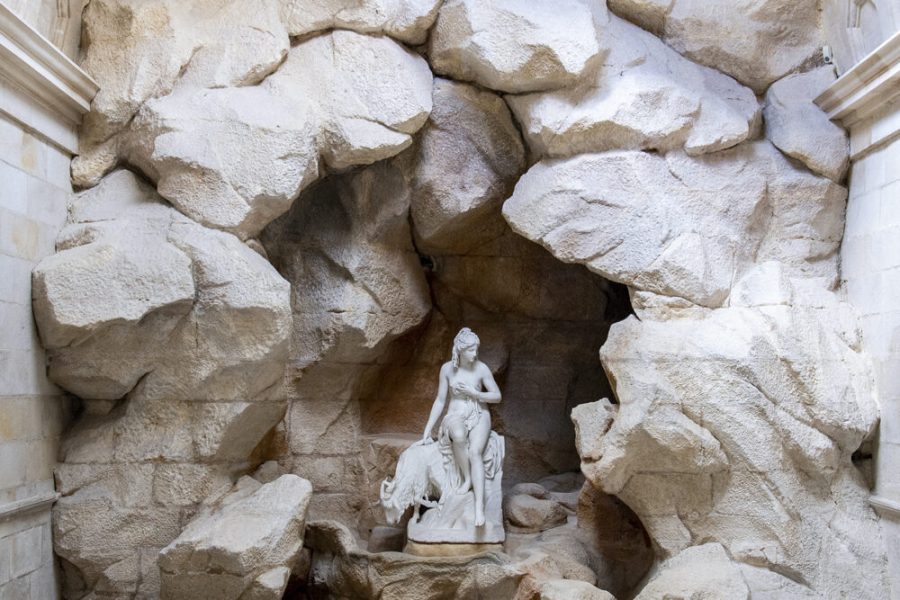
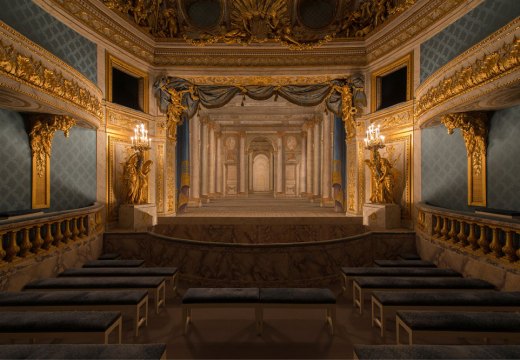
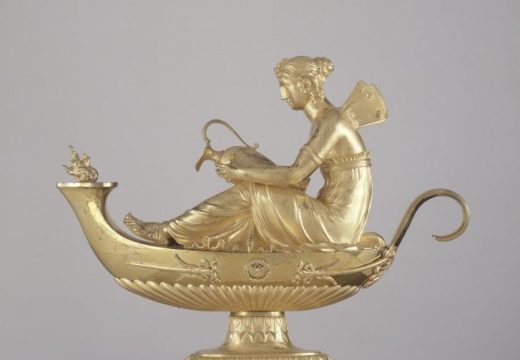
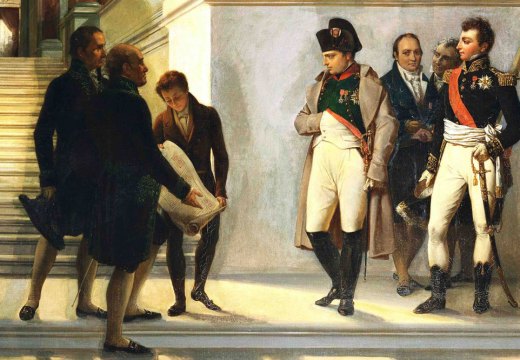









![Masterpiece [Re]discovery 2022. Photo: Ben Fisher Photography, courtesy of Masterpiece London](http://www.apollo-magazine.com/wp-content/uploads/2022/07/MPL2022_4263.jpg)
It’s time for the government of London to return to its rightful home